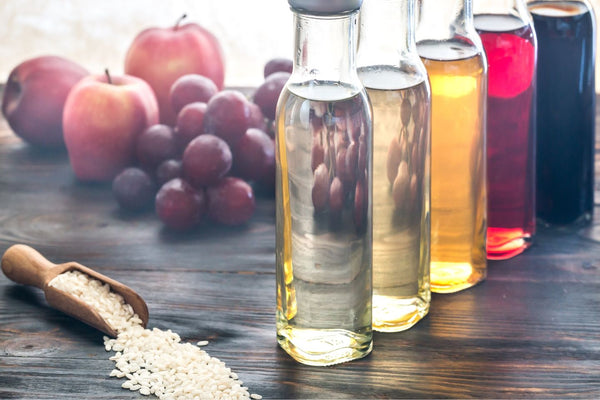
Jump to:
Long before the term “superfoods” entered popular use, the Japanese were incorporating vinegar into their daily routines for both flavor and wellness. Known as su, these Japanese vinegars are traditionally diluted with water, tea, or juice.
The key active component, acetic acid, has been studied for its potential to support digestion, help regulate blood sugar by slowing carbohydrate absorption, and aid appetite control, making it a practical addition to a balanced diet.
This article explores the main types of Japanese vinegar, their flavors, culinary uses, and potential wellness benefits. By understanding the differences, you can select the right variety for your drinks and enjoy the unique flavor of each.
1. Rice-Based Vinegar

Rice vinegar, or komezu, is a traditional Japanese vinegar made from fermented rice or sake lees. It reflects Japan’s long-standing traditions in rice cultivation and fermentation. Check out the top Japanese rice vinegars for cooking, drinks, and sushi or learn about rice wine vs. rice vinegar.
Benefits: Supports digestion, helps regulate blood sugar, and may aid appetite control. Its gentle acidity also contributes to overall wellness.
Flavor Profile: Mild, slightly sweet, and smooth; easy to drink when diluted as a tonic.
Uses: Ideal for seasoning sushi rice, salad dressings, marinades, and pickles. It can also be enjoyed as a daily health drink mixed with water, sparkling water, or herbal tea.
2. Black Vinegar

Black vinegar, called kurozu in Japan and Zhenjiang vinegar in China, is a dark, aged vinegar made from fermented grains such as rice, wheat, or barley. Its extended fermentation creates a rich, complex flavor that sets it apart from lighter vinegars. While similar, kurozu and Zhenjiang vinegar differ in production methods and grain blends, giving each a unique taste profile.
Check out this article for more information on black vinegar.
Flavor Profile: Malty, slightly smoky, subtly sweet, and deeply complex.
Uses: Commonly used as a dipping sauce for dumplings, to season braised dishes, or added to soups and marinades to enhance umami without overpowering other flavors. Also enjoyed as a diluted beverage or blended with honey as a wellness tonic. Check out this recipe for persimmon salad using black vinegar.
Benefits: Rich in amino acids, organic acids, and antioxidants; may support digestion, improve circulation, enhance metabolic function, and aid energy balance. Its versatility makes it a valued ingredient in both traditional recipes and modern health-conscious diets.
3. Grain Vinegar

Grain vinegar, or kokumotsu-su in Japanese, is a versatile vinegar made from fermented grains such as rice, corn, wheat, or barley. It has a lighter, more piercing acidity compared with aged vinegars like black vinegar, making it well-suited for everyday culinary use.
Flavor Profile: Crisp, clean, and sharply acidic.
Uses: Commonly used in marinades, salad dressings, pickling brines, sauces, and for seasoning sushi rice. Its bright tang balances salty and sweet elements and can lighten heavier dishes without overwhelming natural flavors. It’s also used in traditional home remedies and natural cleaning solutions.
Benefits: Contains trace amounts of amino acids and organic acids that may support digestion and help regulate appetite. Its versatility, affordability, and mild flavor make it a staple in both classic and contemporary Japanese cooking.
4. Fruit-Based Vinegar

Fruit vinegar, or kajitsu-su in Japanese, is made by fermenting fruit juices such as apple, grape, plum, or citrus. It retains the natural sweetness, fragrance, and character of the original fruit, resulting in a milder acidity and a refreshing taste. In Japan, plum vinegar (ume-su) and apple vinegar are particularly popular, while apple cider vinegar is more commonly used in Western diets.
As a drinking vinegar, it is typically diluted with water, sparkling water, or tea to create a light, flavorful beverage that supports digestion and overall wellness.
Flavor Profile: Mild acidity with subtle sweetness and a naturally fruity aroma.
Uses: Versatile in both savory and sweet dishes. Commonly added to salad dressings, marinades, dipping sauces, or diluted as a refreshing drink with water or soda. Enhances roasted meats, brightens desserts, and balances flavors in a wide range of recipes.
Benefits: Low in calories and fat, and contains organic acids, polyphenols, and small amounts of vitamins and minerals. May support digestion, help regulate blood sugar, and provide antioxidant activity. Popular among those seeking flavorful, health-conscious alternatives in modern cooking.
5. Blended or Specialty Vinegars

Mixed vinegar blends are carefully crafted combinations of various vinegars, typically grain, black, and fruit, made to highlight specific flavor notes or suit particular culinary purposes. In Japan, these blends are popular for seasonal specialties, celebratory dishes, and health-focused beverages.
Flavor Profile: Balanced and nuanced, combining the crisp acidity of grain vinegar, the deep, mellow richness of black vinegar, and the gentle sweetness of fruit vinegar. The flavor depends on the intended use and the proportion of each component.
Uses: Versatile for both cooking and beverages. Can enhance sushi rice, dipping sauces, braised dishes, or serve as a drinkable mixed vinegar tonic when diluted with water. Tailored blends may suit festive meals, everyday cooking, or wellness routines.
Benefits: Combines the nutritional advantages of multiple vinegars, such as amino acids from black vinegar and refreshing properties from fruit vinegar. Offers flavor complexity and potential health benefits, making it a practical choice for both culinary and functional purposes.
6. Seasoned Vinegar

Seasoned vinegar, or awasezu in Japanese, is a pre-mixed vinegar blend commonly used in Japanese cuisine, especially for preparing sushi rice. It is typically combined with sugar and salt, and sometimes enriched with mirin or kombu broth, to create a harmonious balance of tanginess and gentle sweetness. Sugar content in awasezu can vary widely, as some commercial blends contain more sugar than others, so it’s important to check the label.
Read this article to get practical tips on making sushi rice at home!
Flavor Profile: Tangy yet subtly sweet, with a smooth, well-rounded taste that enhances the natural flavors of dishes.
Uses: Most famously used in sushi rice to provide a glossy finish and complement raw fish. Also used in vinegared salads (sunomono), pickled vegetables, and marinades. Its ready-to-use formulation simplifies seasoning, ensuring consistent flavor in dishes that require precision.
Benefits: Convenient and adaptable, it provides a balanced seasoning base that enhances umami while highlighting the natural taste of ingredients.
Tips on Choosing Japanese Vinegar
Selecting the right Japanese vinegar depends on both its type and how you plan to use it.
- For everyday cooking, grain vinegar delivers a crisp, assertive acidity that’s perfect for dressings, marinades, and pickling.
- If you’re after something softer, rice vinegar offers a gentler, slightly sweet profile that pairs beautifully with sushi rice, light salads, and delicate seafood.
- For richer, more layered dishes like braised meats or dumpling sauces, black vinegar brings depth and umami to the table.
- If you prefer a touch of natural sweetness with a refreshing tang, fruit vinegars are a great choice, ideal for brightening salads or sipping as a diluted tonic.
- Quality matters too. Vinegars made through traditional fermentation tend to offer smoother, more balanced flavors than their mass-produced counterparts.
Enjoy Japanese Vinegars for Flavor and Wellness
Incorporating Japanese vinegars into your daily routine is a simple way to support digestion, balance blood sugar, and add a touch of tradition to modern meals.
By exploring rice, black, grain, fruit, blended, and seasoned vinegars, you can select the perfect variety for your taste and lifestyle. From gentle and sweet to rich and complex, these versatile vinegars make it easy to enjoy both culinary creativity and wellness in every sip or dish!
Do you have a favorite type of Japanese vinegar? Let us know in the comments.


0 comments